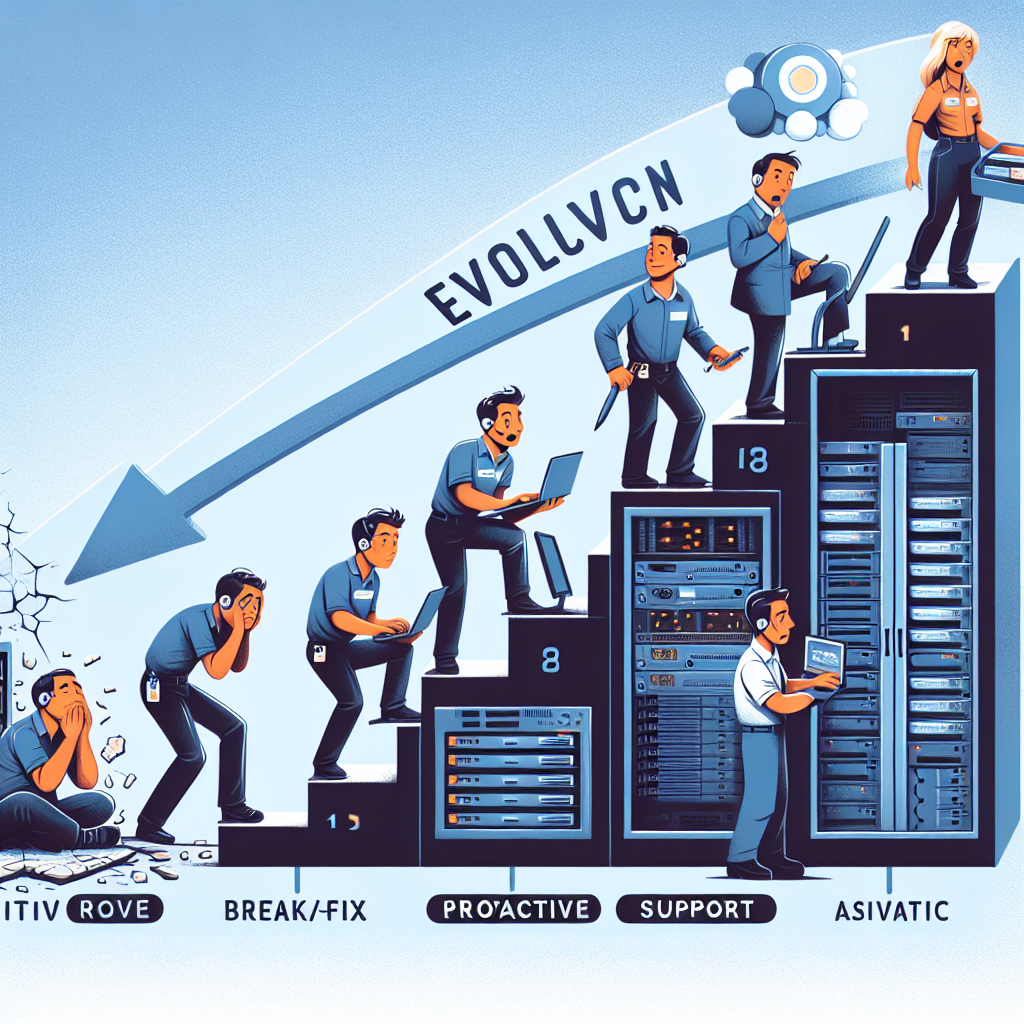Your cart is currently empty!
Tag: BreakFix

The Evolution of Managed Service Providers: From Break-Fix to Proactive Support
Managed Service Providers (MSPs) have come a long way since their inception, evolving from a simple break-fix model to a more proactive and strategic approach to IT support. The shift towards proactive support has been driven by the increasing demands of businesses for reliable and efficient IT services, as well as advancements in technology that allow for more efficient monitoring and management of IT systems.In the early days of IT support, the break-fix model was the norm. Businesses would only call on IT support when something went wrong, resulting in costly downtime and lost productivity. However, as technology became more complex and integral to business operations, this reactive approach to IT support became unsustainable.
Enter the managed service provider. MSPs began offering proactive monitoring and management of IT systems, allowing them to detect and address issues before they became major problems. This shift towards proactive support has been a game-changer for businesses, as it has helped them to prevent downtime, improve productivity, and reduce IT costs.
Today, MSPs not only provide proactive monitoring and management of IT systems, but also offer a range of services such as cloud computing, cybersecurity, and disaster recovery. These services are designed to help businesses stay ahead of the curve and adapt to the ever-changing IT landscape.
One of the key benefits of working with an MSP is the ability to access a team of highly skilled IT professionals that can provide expertise and support across a range of technologies. This allows businesses to focus on their core operations, while leaving the IT support to the experts.
Another benefit of working with an MSP is the cost savings. By outsourcing IT support to a managed service provider, businesses can reduce the need for in-house IT staff and expensive hardware and software purchases. MSPs typically offer flexible pricing models, allowing businesses to pay for only the services they need.
Overall, the evolution of managed service providers from a break-fix model to proactive support has been a positive development for businesses. By partnering with an MSP, businesses can benefit from proactive monitoring and management of their IT systems, access to a team of skilled IT professionals, and cost savings. As technology continues to advance, it is likely that the role of MSPs will only become more important in helping businesses navigate the complex world of IT support.

The Evolution of Managed Services: From Break/Fix to Proactive Support
Managed services have come a long way since the days of the break/fix model. In the past, businesses would only call on IT support when something went wrong, leading to costly downtime and unpredictable expenses. However, the evolution of managed services has transformed the way businesses approach their IT needs, moving from a reactive to a proactive approach.The break/fix model was a simple and straightforward way of managing IT issues – when something broke, you called in the IT support to fix it. However, this model was not only costly but also inefficient, as it meant that businesses were constantly playing catch up with their technology.
Enter managed services, a more holistic approach to IT support that focuses on preventing issues before they occur. With managed services, businesses partner with an IT provider who monitors their systems 24/7, identifies potential problems, and resolves them before they impact operations. This proactive approach not only minimizes downtime but also reduces overall IT costs in the long run.
The evolution of managed services has also seen a shift towards more strategic and personalized support. Providers now offer a range of services tailored to the specific needs of each business, from network security to cloud management. This personalized approach allows businesses to scale their IT support as they grow, without having to invest in expensive in-house resources.
Another key development in the evolution of managed services is the shift towards cloud-based solutions. Cloud computing has revolutionized the way businesses store and access data, offering greater flexibility, scalability, and security. Managed service providers now offer cloud management services, helping businesses migrate to the cloud and ensuring their data is secure and accessible at all times.
Overall, the evolution of managed services has transformed the way businesses approach their IT needs, moving from a reactive break/fix model to a proactive, strategic, and personalized approach. By partnering with a managed service provider, businesses can ensure their technology is always up and running, allowing them to focus on what they do best – growing their business.

Beyond the Break-Fix Mentality: How a Comprehensive Maintenance Plan Can Save Your Data Center
In today’s fast-paced digital world, data centers play a crucial role in storing and processing vast amounts of information for businesses of all sizes. However, simply setting up a data center and hoping for the best is not enough. To ensure the smooth operation of your data center and prevent costly downtime, it is essential to go beyond the break-fix mentality and implement a comprehensive maintenance plan.The break-fix mentality is a reactive approach to maintenance where problems are only addressed once they have already occurred. While this approach may seem cost-effective in the short term, it can lead to increased downtime, loss of productivity, and potential data loss in the long run. By proactively maintaining your data center, you can identify and address potential issues before they escalate into major problems.
A comprehensive maintenance plan for your data center should include regular inspections, preventive maintenance tasks, and the use of advanced monitoring tools to keep track of the health and performance of your equipment. By staying on top of maintenance tasks and monitoring key performance metrics, you can detect and resolve issues early on, preventing them from causing major disruptions to your operations.
In addition to preventing downtime, a comprehensive maintenance plan can also extend the lifespan of your equipment and improve its overall efficiency. Regular maintenance tasks such as cleaning, lubricating, and replacing worn-out parts can help optimize the performance of your data center equipment, reducing energy consumption and lowering operational costs in the process.
Furthermore, a well-maintained data center is better equipped to handle unexpected events such as power outages, equipment failures, or natural disasters. By having a solid maintenance plan in place, you can ensure that your data center is prepared to weather any storm and continue operating smoothly even in the face of adversity.
Ultimately, investing in a comprehensive maintenance plan for your data center is not just about preventing downtime and saving money – it is about protecting the integrity of your business-critical data and ensuring the continuity of your operations. By taking a proactive approach to maintenance and prioritizing the health and performance of your data center equipment, you can safeguard your business against potential risks and position yourself for long-term success in the digital age.

The Evolution of Managed Services: From Break-Fix to Proactive Support
Managed services have come a long way in the past few decades, evolving from a simple break-fix model to a proactive support system that helps businesses prevent issues before they even arise. This shift in approach has revolutionized the way businesses manage their IT infrastructure and has proven to be a game-changer for companies of all sizes.The break-fix model, which was the traditional approach to IT support, involved businesses calling in a service provider only when something went wrong with their systems. This reactive approach often resulted in downtime, lost productivity, and increased costs as businesses had to pay for each service call and the time it took to fix the issue. This model was not only inefficient but also left businesses vulnerable to potential cybersecurity threats and data breaches.
As technology continued to advance, businesses realized the importance of proactive IT management to prevent downtime and ensure the smooth operation of their systems. This led to the evolution of managed services, where businesses could outsource their IT support to a third-party provider who would proactively monitor and manage their systems on an ongoing basis.
Proactive support involves regular monitoring of a company’s IT infrastructure to identify and address potential issues before they become major problems. This approach allows businesses to avoid costly downtime, improve efficiency, and enhance security by staying ahead of potential threats.
Managed service providers now offer a range of services, including network monitoring, data backup and recovery, cybersecurity, cloud services, and help desk support. By partnering with a managed service provider, businesses can offload the burden of managing their IT infrastructure and focus on their core business operations.
One of the key benefits of proactive support is cost savings. By preventing issues before they arise, businesses can avoid costly downtime and repairs, resulting in overall lower IT costs. Additionally, proactive support can help businesses improve their operational efficiency and productivity by ensuring that their systems are always up and running smoothly.
Another major benefit of proactive support is enhanced security. With the increasing number of cybersecurity threats, businesses need to ensure that their systems are protected from potential breaches. Managed service providers can implement security measures such as firewalls, antivirus software, and regular security updates to prevent cyberattacks and keep sensitive data safe.
Overall, the evolution of managed services from a break-fix model to proactive support has transformed the way businesses manage their IT infrastructure. By partnering with a managed service provider, businesses can benefit from proactive monitoring, cost savings, enhanced security, and improved operational efficiency. In today’s fast-paced and technology-driven business environment, proactive support is essential for staying ahead of the competition and ensuring the success of your business.

From Break-Fix to Proactive: How MSPs are Transforming IT Support
In the world of IT support, the traditional break-fix model is quickly becoming outdated. With the rapid advancement of technology and the increasing complexity of IT systems, businesses are looking for more proactive and preventive solutions to keep their systems running smoothly. This is where Managed Service Providers (MSPs) come in, offering a new approach to IT support that focuses on proactive monitoring, maintenance, and problem-solving.The break-fix model, which involves fixing IT issues only when they arise, is no longer sufficient for today’s businesses. It often leads to downtime, lost productivity, and costly emergency repairs. MSPs, on the other hand, take a proactive approach to IT support, monitoring systems 24/7, identifying potential issues before they become major problems, and implementing preventive measures to keep systems running smoothly.
One of the key benefits of working with an MSP is the predictability of costs. With a fixed monthly fee, businesses can budget for IT support without worrying about unexpected expenses for emergency repairs. This also allows businesses to focus on their core operations, knowing that their IT systems are being monitored and maintained by professionals.
MSPs also offer a higher level of expertise and support than traditional break-fix providers. They have a team of skilled technicians and engineers who are constantly monitoring systems, staying up-to-date on the latest technologies, and providing proactive solutions to prevent downtime and data loss.
Another advantage of working with an MSP is access to advanced tools and technologies that can improve the efficiency and security of IT systems. From remote monitoring and management to automated patch management and security updates, MSPs offer a range of services that can help businesses stay ahead of potential threats and vulnerabilities.
Overall, the shift from break-fix to proactive IT support is transforming the way businesses manage their IT systems. By partnering with an MSP, businesses can benefit from proactive monitoring, preventive maintenance, and access to advanced technologies that can improve the efficiency and security of their IT systems. As technology continues to evolve, MSPs will play an increasingly important role in helping businesses stay competitive and secure in the digital age.

The Evolution of Managed Service Providers: From Break/Fix to Proactive Support
Managed Service Providers (MSPs) have come a long way from their origins as break/fix IT service providers. In the early days of IT support, businesses would only call on a service provider when something went wrong with their technology. This reactive approach to IT support was costly and inefficient, as businesses would often experience downtime and lost productivity while waiting for a technician to come and fix the problem.As technology advanced and became more integral to business operations, the need for a more proactive approach to IT support became apparent. This shift in mindset led to the evolution of MSPs, who now offer proactive support and ongoing monitoring of their clients’ IT systems. Instead of waiting for something to break, MSPs now work to prevent issues from occurring in the first place.
One of the key advantages of working with an MSP is that they can provide businesses with a comprehensive IT solution that includes proactive monitoring, maintenance, and support. This allows businesses to focus on their core operations, knowing that their IT systems are being taken care of by experts.
MSPs also offer scalability and flexibility, allowing businesses to easily adjust their IT support services as their needs change. Whether a business is looking to expand its operations or streamline its processes, an MSP can provide the necessary support and expertise to help them achieve their goals.
In addition to traditional IT support services, many MSPs now offer cloud computing, cybersecurity, and other advanced technology solutions to help businesses stay competitive in today’s fast-paced digital world. By partnering with an MSP, businesses can access the latest technology and expertise without the need to invest in costly infrastructure and personnel.
Overall, the evolution of MSPs from break/fix to proactive support has revolutionized the way businesses manage their IT systems. By taking a proactive approach to IT support, businesses can minimize downtime, reduce costs, and improve overall efficiency. As technology continues to advance, MSPs will play an increasingly important role in helping businesses leverage the power of technology to achieve their goals.

The Evolution of MSPs: From Break-Fix to Proactive IT Management
Managed Service Providers (MSPs) have come a long way since the days of traditional break-fix IT support. In the past, businesses would only call on IT providers when something went wrong with their technology, leading to costly downtime and reactive solutions. However, the evolution of MSPs has transformed the way organizations manage their IT infrastructure, moving from a reactive break-fix model to a proactive approach to IT management.The shift from break-fix to proactive IT management has been driven by advancements in technology, changes in the business landscape, and the growing complexity of IT systems. MSPs now offer a range of services that go beyond just fixing problems when they arise. They provide proactive monitoring, maintenance, and support to ensure that a company’s IT systems are running smoothly and efficiently at all times.
One of the key benefits of proactive IT management is that it helps prevent issues before they occur. MSPs use monitoring tools and automated processes to identify potential problems and address them before they cause downtime or disruptions to business operations. This proactive approach not only reduces the risk of IT failures but also improves overall system performance and reliability.
Another important aspect of proactive IT management is the focus on strategic planning and technology alignment. MSPs work closely with their clients to understand their business goals and objectives, and then develop customized IT solutions to support those goals. This includes implementing new technologies, optimizing existing systems, and ensuring that IT resources are aligned with the organization’s strategic vision.
In addition to proactive monitoring and strategic planning, MSPs also offer a range of other services to help businesses optimize their IT environment. This may include cloud computing, cybersecurity, data backup and recovery, and IT consulting services. By outsourcing these tasks to an MSP, organizations can focus on their core business activities while leaving the management of their IT infrastructure to the experts.
Overall, the evolution of MSPs from break-fix to proactive IT management has transformed the way businesses approach technology. By proactively managing their IT systems, organizations can reduce downtime, improve performance, and align their technology with their business goals. As technology continues to evolve, MSPs will play an increasingly important role in helping businesses navigate the complex IT landscape and achieve their strategic objectives.
